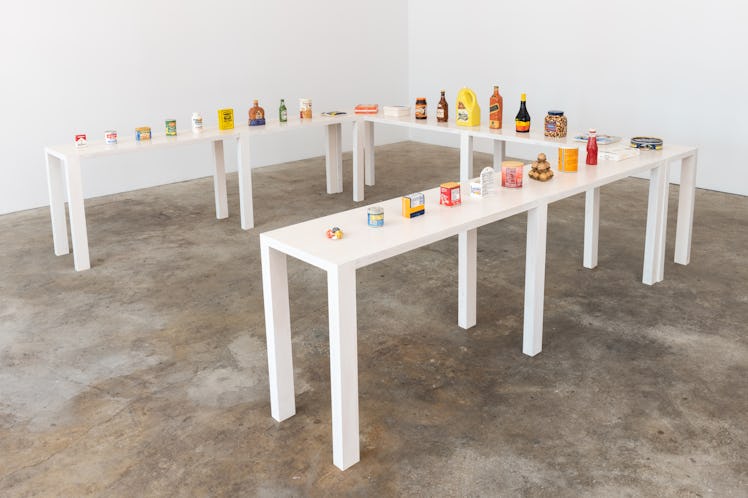Hennessy, Heinz, and Spam: Artist Stephanie Shih Honors Asian Kitchen Staples

Ask any member of the Asian diaspora and they’ll tell you about the suitcase, or the brown cardboard box, or the plaid nylon bag. Whichever form the vessel takes, it gets brought back to the homeland absolutely filled with goodies from the United States: American snacks, candies, liquor, and whatever else the family in Asia requested you bring over. For the Brooklyn-based artist Stephanie Shih, visits to her mother and father’s native Taiwan in the 1980s and 1990s meant packing her suitcase with cases of vitamins and Ferrero Rocher chocolates.
“There was this idea that American vitamins were better quality,” she says over Zoom from Los Angeles. “You couldn’t get those in Taiwan at the time—we didn’t have the same global commerce supply chains back then. And, for some reason, American candy was considered to be primo, even though I think Asian candy is so much better.”
Shih’s latest work, on view at the new L.A. gallery Stanley’s until September 3, pays homage to the foodstuffs and goods that are hallmarks of Asian culture, but which have roots in the West—like those coveted items inside the suitcase. Titled New World Mall, the exhibition features life-sized ceramic sculptures of Spam, Libby’s Vienna Sausages (which is used for Filipino meatloaf and Korean “army stew”), and Carnation Condensed Milk—the sweetening agent in Vietnamese coffee and what’s used on toast from Hong Kong and Taipei in lieu of butter.
Ferrero Rocher, 2019-21.
Centrum Multivitamins, 2021.
Some of these groceries’ significance is rooted in the histories of colonization and American military presence, Shih says. “When people talk about cultural authenticity, especially in the States for children of immigrants, they’re often trying to put a fence around what is authentic and what is not. Some Chinese Americans say, this is what Chinese food is—fast food, Chinese American takeout, that’s not Chinese food,” the artist explains. “But just because things that you might not like have happened to our culture or cuisine does not mean they aren’t authentic. I am very interested in the idea that that is part of our heritage and our history.”
Installation view of Stephanie H. Shih's, New World Mall.
The idea of military occupation is certainly unsavory—but it has undoubtedly contributed to the creation of Asian diasporic food culture. Take Heinz ketchup, for instance (which makes an appearance in Shih’s exhibition). It’s a wholly American condiment, but the Japanese adopted it as a tomato sauce stand-in for spaghetti dishes after World War II. Maggi Seasoning—an umami flavoring sauce that’s a staple in most Asian kitchens—was actually founded in Switzerland. To select which items would be included in New World Mall, Shih took to social media, polling her 25,000+ followers on Instagram about the contents of their proverbial suitcases. She knew she’d have to crowdsource this information from other Asian people, since her purview was limited to the preferences of her Chinese family in Taiwan.
“Obviously, my experience is only my personal experience,” she says. “I didn’t know, for instance, that Hennessy and Heineken are the two drinks that you always have at Vietnamese gatherings.”
Maggi Seasoning, 2021.
Heinz Tomato Ketchup, 2021.
Shih notes that although she’s been working on this exhibition since 2018, she sees her whole body of work as reactive. Most artists have an idea of the vision they’d like to put into the world, but the inspiration for Shih’s pieces are generated through collaboration with friends, family, and her followers on Instagram—all of whom expressed that the idea of the suitcase and its contents, whether coming to or from Asia or the United States—struck a chord. When Shih saw that this concept resonated universally with her audience, she knew she had to pursue it fully.
“I hear a lot of people talking about their American self versus their Asian self,” Shih adds. “But I think that dichotomy is a red herring. I don’t think it exists. You are whoever you are, and your roots are always intertwined.”
This article was originally published on